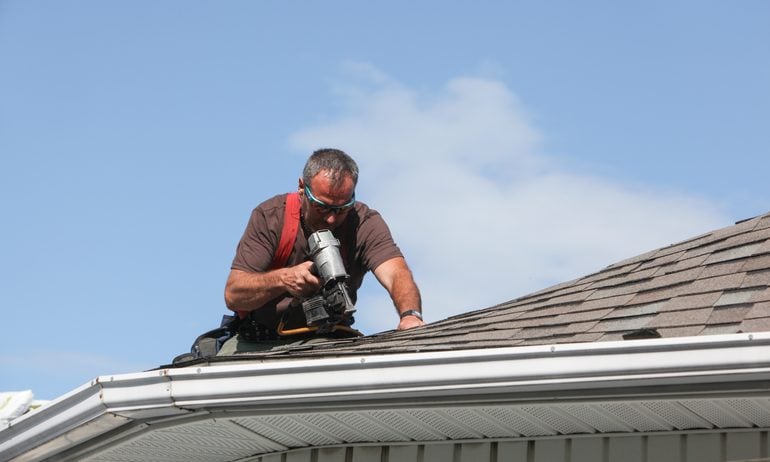How Your Credit Score Affects Homeowners Insurance
In most states, insurers use what’s known as a credit-based insurance score to help determine home insurance rates.

Many, or all, of the products featured on this page are from our advertising partners who compensate us when you take certain actions on our website or click to take an action on their website. However, this does not influence our evaluations. Our opinions are our own. Here is a list of our partners and here's how we make money.
For people with poor credit, buying a house can be challenging — and expensive. Once you find a lender that’s willing to offer you a mortgage, you’ll probably have a higher interest rate than someone with good credit. And you could also pay significantly more for homeowners insurance.
A NerdWallet rate analysis found that a person with good credit would pay $2,110 per year for homeowners insurance, on average. But in most states, someone with poor credit would see an average premium of $3,620 per year — over 71% more.
Each insurer has its own definitions of “good” and “poor” credit, but they’re generally in line with traditional credit score ranges. A good credit score typically falls between 690 and 719, while below 630 is considered a bad score.
How credit affects home insurance rates
Since the 1990s, insurance companies have used credit-based insurance scores to help measure how risky someone might be to insure. Companies can use these scores to set your rates or to decide whether to sell you a policy at all.
A credit-based insurance score is similar to a traditional credit score but weighted a bit differently. Both scores look at factors such as how much debt you have and whether you’ve made payments on time.
Unlike your mortgage lender or credit card issuer, insurers generally aren’t using your credit history to judge your ability to pay your premiums. Instead, they’re trying to predict how likely you are to file a claim. Studies have shown that those with lower credit-based insurance scores are responsible for a higher share of claim payouts.
A greater chance of filing a claim means a greater risk for the insurance company — and a higher rate for you.
Below you can see how much more homeowners with poor credit can expect to pay in your state. (We didn’t include states where insurers can’t take credit scores into account when pricing policies.)
Rates reflect the average annual cost of homeowners insurance for a policy with $300,000 in dwelling coverage, $300,000 in liability coverage and a $1,000 deductible.
State | Good credit | Poor credit | Difference |
|---|---|---|---|
$3,420 | $5,820 | 70% | |
$1,035 | $1,930 | 86% | |
$2,565 | $4,885 | 90% | |
$3,215 | $6,710 | 109% | |
$4,175 | $6,570 | 57% | |
$1,870 | $3,610 | 93% | |
$1,025 | $2,375 | 132% | |
$2,625 | $3,855 | 47% | |
$2,435 | $4,275 | 76% | |
$610 | $660 | 8% | |
$1,460 | $2,595 | 78% | |
$2,420 | $4,765 | 97% | |
$2,495 | $4,775 | 91% | |
$2,505 | $4,520 | 80% | |
$3,735 | $6,110 | 64% | |
$2,510 | $4,295 | 71% | |
$2,220 | $4,110 | 85% | |
$1,180 | $2,085 | 77% | |
$2,095 | $4,065 | 94% | |
$2,920 | $4,585 | 57% | |
$3,310 | $7,075 | 114% | |
$3,290 | $6,195 | 88% | |
$2,735 | $6,400 | 134% | |
$4,505 | $7,315 | 62% | |
$1,305 | $2,485 | 90% | |
$1,185 | $2,060 | 74% | |
$1,290 | $2,530 | 96% | |
$1,730 | $4,230 | 145% | |
$1,740 | $2,555 | 47% | |
$2,490 | $3,205 | 29% | |
$2,805 | $4,460 | 59% | |
$1,590 | $3,010 | 89% | |
$6,210 | $10,115 | 63% | |
$1,305 | $2,770 | 112% | |
$1,440 | $2,915 | 102% | |
$2,080 | $3,475 | 67% | |
$2,350 | $4,230 | 80% | |
$3,345 | $6,135 | 83% | |
$2,850 | $6,060 | 113% | |
$4,585 | $7,545 | 65% | |
$1,385 | $2,815 | 103% | |
$950 | $1,615 | 70% | |
$1,705 | $3,455 | 103% | |
$1,415 | $1,895 | 34% | |
$1,295 | $2,410 | 86% | |
$1,770 | $4,010 | 127% | |
$1,515 | $3,140 | 107% | |
$1,555 | $2,895 | 86% |
Is it fair to use credit history to set home insurance rates?
Some consumer advocacy organizations have spoken out against the use of credit in setting insurance rates. They argue that the practice has an unfair impact on people of color, who often have lower credit scores than white people, as a group.
The COVID-19 pandemic only worsened this racial gap. Minority households were more likely to lose employment income and to struggle with making mortgage payments during the pandemic, according to a study from Harvard University’s Joint Center for Housing Studies.
The most affordable companies for homeowners with poor credit
Each insurance company uses its own complex formula to set homeowners insurance rates, so people with poor credit may pay less with some companies than with others. Below are a few major insurers’ average annual rates for homeowners with poor credit.
Company | Average annual rate |
|---|---|
$3,555 | |
$3,655 | |
$3,905 | |
$3,920 | |
$4,820 | |
$5,075 | |
$5,185 | |
$6,965 | |
USAA* | $3,885 |
*USAA homeowners policies are available only to active military, veterans and their families. | |
How to pay less for homeowners insurance
Shop around. The best way to find more affordable insurance is to check rates from multiple companies. You can get homeowners insurance quotes online or ask an independent agent to shop around on your behalf. Double-check that each quote has similar coverage amounts and deductibles to ensure a fair comparison.
Improve your credit. In the longer term, improving your credit can save you hundreds of dollars a year on homeowners insurance. Paying your bills on time and using less of your available credit can help. Learn more about rebuilding your credit.
Ask about discounts. Check with your insurer or agent to make sure you’re getting all the home insurance discounts you’re eligible for. Many carriers offer savings if you bundle multiple policies (such as homeowners and auto) or have protective devices such as burglar alarms or smoke detectors.
For more tips, see how to lower your home insurance cost.
NerdWallet calculated median rates for 40-year-old homeowners from various insurance companies in the 25 largest cities in each state by population. All rates are rounded to the nearest $5.
Sample homeowners were nonsmokers with good credit living in a single-family, two-story home built in 1984. They had a $1,000 deductible and the following coverage limits:
$300,000 in dwelling coverage.
$30,000 in other structures coverage.
$150,000 in personal property coverage.
$60,000 in loss of use coverage.
$300,000 in liability coverage.
$1,000 in medical payments coverage.
We made minor changes to the sample policy in cases where rates for the above coverage limits or deductibles weren’t available.
We changed the credit tier from “good” to “poor,” as reported to the insurer, to see rates for homeowners with poor credit.
These are sample rates generated through Quadrant Information Services. Your own rates will be different.





